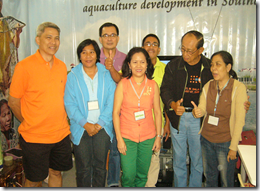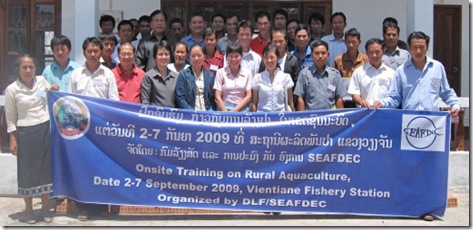 Lao PDR played host to the first session of the Human resources development (HRD) on-site training course on rural aquaculture from September 1 to 7.
Lao PDR played host to the first session of the Human resources development (HRD) on-site training course on rural aquaculture from September 1 to 7.
The training, aimed to build the capacity of farmers in rural aquaculture to improve their livelihood and alleviate poverty, was conducted in the Nalao clusters of PhonHong District, Vientiane Province.
AQD Scientist Dr. Maria Rowena Eguia and Training and Information Division Head Mr. Renato Agbayani provided technical and logistical support during the training, which was coordinated by Ms. Nouhak Liepvisay and Mr. Akhane Phomsouvanh of the Lao PDR Department of Livestock and Fisheries (DLF). The training gave Ms. Liepvisay the opportunity to share the skills and knowledge she acquired as one of the participants in the Training of trainers on HRD held at AQD last November 10-19, 2008.
The first leg of the training focused on freshwater aquaculture, particularly in tilapia and integrated fish farming/polyculture. Topics discussed during the seven-day activity included site selection; cage/pond design and construction; water and fish health management; seed production, nursery and grow-out techniques for tilapia and other freshwater species; feeds and feeding; and costs-and-returns analysis. Also scheduled were field demonstrations and visits to the Agricultural Development and Service Center, the fish processing areas in Vang Vieng, and the farm site of one of the trainees.
The trainees found the training generally satisfactory. According to Dr. Eguia, the training was a work-in-progress, with a flexible schedule where topics varied depending on the needs and demands expressed by the trainees.
The training in Lao PDR was the first in a series of 8 sessions, with one each to be conducted in 8 SEAFDEC member-countries.
The training series is being implemented by SEAFDEC as a center-wide project under the HRD on poverty alleviation and food security by fisheries intervention in the ASEAN region. It is funded by the Japan-ASEAN Solidarity Fund of the ASEAN Foundation.
AQD assists in HRD training in Lao PDR
Dignitaries from Saudi Arabia visit AQD
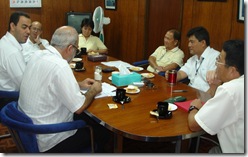 Dr. Anwar Eissa Al-Sunaiher, Aquaculture Department Director of the Ministry of Agriculture of Riyadh, Kingdom of Saudi Arabia (KSA); Mr. Baheej Mohammad Rasem, Fish Farming Center (FFC) Director of Jeddah, KSA were at AQD’s Tigbauan Main Station (TMS) last August 3-7.
Dr. Anwar Eissa Al-Sunaiher, Aquaculture Department Director of the Ministry of Agriculture of Riyadh, Kingdom of Saudi Arabia (KSA); Mr. Baheej Mohammad Rasem, Fish Farming Center (FFC) Director of Jeddah, KSA were at AQD’s Tigbauan Main Station (TMS) last August 3-7.
Dr. Al-Sunaiher and Mr. Baheej were accompanied by Dr. Felix Ayson, a former AQD scientist and currently the Chief Technical Adviser of the Food and Agriculture Organization (FAO) of the United Nations. They visited AQD to learn about its various research programs and to see its research facilities.
On their first day at TMS, they were briefed about AQD’s research activities by Research Division Head Dr. Evelyn Grace Ayson. Specialists on AQD’s research programs, namely Dr. Mae Catacutan (Nutrition and feed development),
Dr. Gilda Lio-Po (Fish health), Dr. Relicardo Coloso (Marine fish), Dr. Fe Dolores Estepa (Mud crab and shrimp domestication), and Ms. Ma. Rovilla Luhan (Seaweed strain improvement) were also present during the meeting.
After the briefing, they were toured to the hatcheries and laboratories.
 The next day, the visitors met with AQD’s top management to discuss future collaborations between AQD and FFC. After which, they visited the AQD library and were briefed about its collections and operation.
The next day, the visitors met with AQD’s top management to discuss future collaborations between AQD and FFC. After which, they visited the AQD library and were briefed about its collections and operation.
They also toured AQD’s Dumangas Brackishwater Station and Igang Marine Station during their visit. In addition, they met with Technology Verification and Demonstration Division and Training and Information Division officials headed by Dr. Clarissa Marte and Mr. Renato Agbayani, respectively to have an overview of their activities.
AQD scientist honored by Japan
 AQD scientist Dr. Junemie Hazel Lebata-Ramos was honored by Japan’s Ministry of Agriculture, Forestry, and Fisheries (MAFF) as a recipient of its 2009 Japan International Award for Young Agricultural Researchers.
AQD scientist Dr. Junemie Hazel Lebata-Ramos was honored by Japan’s Ministry of Agriculture, Forestry, and Fisheries (MAFF) as a recipient of its 2009 Japan International Award for Young Agricultural Researchers.
The award-winning research work of Dr. Ramos was on Stock enhancement of commercially important and threatened marine invertebrates (such as mud crab, abalone, giant clam, and angelwing clam) in tropical areas.
MAFF began the award program in 2007 to recognize the contribution of young agricultural researchers to technological development for the improvement of food security and the environment in developing countries.
Japan International Research Center for Agricultural Sciences (JIRCAS) supports this program and offers financial
incentive to the winners.
The awarding ceremony will be on November 4 at the University of Tokyo, Japan.
Misamis Occidental gears up for mariculture after grouper spawning
 Grouper broodstock in Misamis Occidental successfully spawned after two months of conditioning, jumpstarting the development of the mariculture industry in the province.
Grouper broodstock in Misamis Occidental successfully spawned after two months of conditioning, jumpstarting the development of the mariculture industry in the province.
The broodstock were conditioned for two months in a hatchery at the Misamis Occidental Aquamarine Park (MOAP) before finally producing 15 million eggs last August and another 22 million eggs in September.
With the volume of eggs, MOAP hatchery manager Tito Piloton says they are already having trouble finding space for all the grouper larvae produced from the spawned eggs.
The P8.8-million hatchery features two 160-ton broodstock tanks, eight 15-ton larval tanks, twelve 15-ton natural food tanks, a 135-ton reservoir, and a generator.
It was completed December last year through the collaboration of the Australian government through the Philippine-Australia Local Sustainability (PALS) Program, the Misamis Occidental Provincial Government, and the Southeast Asian Fisheries Development Center (SEAFDEC).
SEAFDEC Aquaculture Department Chief Dr. Joebert Toledo explained that the spawning is a very good development for Misamis Occidental because “grouper broodstock spawn year-round” providing a stable and accessible supply of grouper seed which will be needed by fish cage farmers.
SEAFDEC has been optimizing the breeding and hatchery of grouper since 1989 and is now providing the technical support, technology, and supervision for the MOAP hatchery.
With the projected growth in hatchery production, MOAP manager Manoling Yap hopes to construct additional larval rearing tanks for the hatchery, a feed mill, and eventually also set up mariculture cages in Panguil Bay.
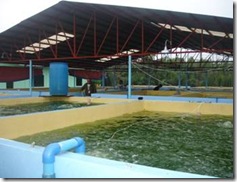 Misamis Occidental Governor Loreto Leo Ocampos is pushing for the farming of grouper in floating sea cages. To date, a corporation, owned by 4 multi-purpose cooperatives and an NGO, has set up 32 nursery cages and 16 grow-out cages off the town of Panaon and a cooperative has 4 nursery and 3 grow-out cages off the town of Sincaban.
Misamis Occidental Governor Loreto Leo Ocampos is pushing for the farming of grouper in floating sea cages. To date, a corporation, owned by 4 multi-purpose cooperatives and an NGO, has set up 32 nursery cages and 16 grow-out cages off the town of Panaon and a cooperative has 4 nursery and 3 grow-out cages off the town of Sincaban.
Grouper (Epinephelus sp.) is locally known as lapu-lapu, which is a highly valued marine fish with great demands both in the local and international markets.
Aside from grouper, the MOAP hatchery is also projected to produce milkfish, tilapia, catfish, mud crabs, and seaweed. The seed will then be used to supply fishponds and fish cages in Panguil Bay, Murcilleagus Bay, and coastal coves around the province.
The MOAP project aims to create direct and indirect employment for coastal fish farmers, promote aquaculture; and help the province become a major provider of agri-aqua products in Northern Mindanao through equitable coastal resources management and sustainable aquaculture development.
Milkfish cage culture training in Guimaras
The Season-long training course on milkfish cage culture, which is implemented in four barangays in Nueva Valencia, Guimaras continues to make significant progress. The training course is part of a collaborative pilot project on Mariculture livelihood program for Guimaras fisherfolks between AQD, Petron Foundation Inc, and Citi Philippines.
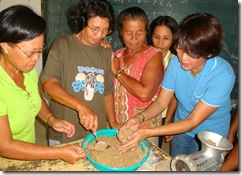 Brgy. San Antonio advances to Module 2. Thirty fisherfolk from Brgy. San Antonio advanced to Module 2. The training, which was held last August 13-14 at Roma Beach Resort, covered topics on stock sampling, feed and feeding practices, and cage maintenance.
Brgy. San Antonio advances to Module 2. Thirty fisherfolk from Brgy. San Antonio advanced to Module 2. The training, which was held last August 13-14 at Roma Beach Resort, covered topics on stock sampling, feed and feeding practices, and cage maintenance.
AQD scientists Dr. Mae Catacutan and Dr. Relicardo Coloso were the resource persons for aquafeed preparation and feed & feeding practices respectively.
IMS staff Mr. Alex Babol on the other hand was the resource person for stock sampling and cage maintenance.
Igang, Magamay and Sto. Domingo move on to Module 3. Meanwhile, a total of 92 participants from the barangays of Igang, Magamay and Sto. Domingo advanced to Module 3.
The training took place at the Nueva Valencia Municipal Gymnasium from September 24 to 25.
 The trainees learned about aquaculture business planning and sustainable management from Mr. Renato Agbayani, Head of AQD’s Training and Information Division. Scientist Dr. Edgar Amar then lectured on fish disease management, followed by a practical session on how to prepare and send fish samples to the laboratory for disease analysis.
The trainees learned about aquaculture business planning and sustainable management from Mr. Renato Agbayani, Head of AQD’s Training and Information Division. Scientist Dr. Edgar Amar then lectured on fish disease management, followed by a practical session on how to prepare and send fish samples to the laboratory for disease analysis.
On the second day, Igang Marine Station Head Mr. Albert Gaitan talked about cage culture design. He also discussed the factors to consider in cage setup, and the advantages and limitations of rearing fish in cages.
Financial analysis in aquaculture was tackled by Senior Technical Assistant Ms. Dianne Hope Tormon. The trainees learned concepts such as return-on-investment and break-even production and how to analyze these to determine the profitability of the project.
Researcher Ms. Didi Baticados discussed the development and management of cooperatives for sustainable aquaculture. She stressed that the success of the organization depends on the cooperation among the members.
A survey on business organizations and arrangements for managing a fish cage culture project was conducted by Ms. Tormon after the lectures.
AQD holds strategic planning meeting

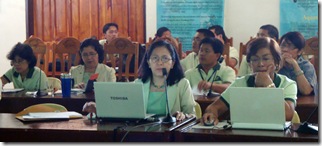 AQD senior staff gathered for the Review and planning meeting from September 16 to 18 held at AQD’s Tigbauan Main Station.
AQD senior staff gathered for the Review and planning meeting from September 16 to 18 held at AQD’s Tigbauan Main Station.
The objectives of the meeting were to (1) review the progress of activities implemented in 2009 and ensure that these are within the agreed strategic objectives for 2012; (2) discuss planned activities for 2010 and assess any changes to AQD’s strategic plan; and (3) ensure harmonization and complementation of activities among the four AQD divisions.
AQD Chief Dr. Joebert Toledo gave his opening remarks and presented AQD’s new vision and mission. He also stated that for 2010, the SEAFDEC Council has advised AQD to slowly change its approach from being commodity-based to a thematic one.
Presented during the 3-day activity were the accomplishments and plans of AQD’s departmental programs (marine fish, crustaceans, molluscs, seaweeds, small-holder freshwater aquaculture, and aquatic ecology), regional programs (stock enhancement, fish disease surveillance, and sustainable aquaculture), other R&D activities (ABOT AquaNegosyo, ICD-SA, training & information) and administration & finance (budgeting & accounting, human resources management, support services). An open forum followed each session to discuss issues, problems and recommendations. Some of these concerns included climate change, reducing pollution, upgrading of AQD infrastructure, intellectual property rights (IPR), and internal auditing protocols.
Dr. Toledo closed the meeting by saying that AQD remains steadfast in its goal to develop science-based aquaculture technologies. He urged everyone to “move forward, and create the change that we desire. Let’s do it!”
Abalone symposium, dialogue in Thailand
Senior Technical Assistant Mr. Vincent Encena II presented the country technical report on The Philippine abalone industry: status, research and aquaculture potential at the 7th International abalone symposium held in Pattaya, Thailand from July 19 to 24.
The symposium brought together scientists, growers, suppliers, buyers, distributors, managers, regulators and policy/decision makers who are interested in abalone fisheries and aquaculture.
Other countries which presented reports on their abalone industries included Australia, Chile, China, Japan, Mexico, New Zealand, South Africa, Thailand and the United States.
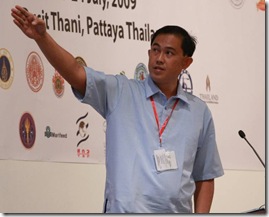 Topics on pathology & diseases; fisheries & ecology management; genetics & biotechnology; biology & physiology; larval biology; and nutrition & biochemistry were also tackled.
Topics on pathology & diseases; fisheries & ecology management; genetics & biotechnology; biology & physiology; larval biology; and nutrition & biochemistry were also tackled.
The symposium participants also toured the Sichang Marine Science Research and Training Station’s abalone hatchery in Koh Sichang under the management of Chulalongkorn University.
Mr. Encena also participated in the World Wildlife Fund-Abalone Aquaculture Dialogue (WWF-AAD), which was held last July 25-26. The WWF-AAD is a series of meetings geared towards developing global environmental standards for farmed abalone. Mr. Encena volunteered to be a steering committee member of WWF-AAD. In addition, he represents the Philippines in the International Abalone Society (IAS).
Discussion on impact assessment methodologies
 Scientist Dr. Ma. Lourdes Aralar participated in the Roundtable discussion on impact assessment methodologies in the fisheries sector from September 9-10 at PCAMRD (Philippine Council for Aquatic and Marine Research and Development), Los Baños, Laguna.
Scientist Dr. Ma. Lourdes Aralar participated in the Roundtable discussion on impact assessment methodologies in the fisheries sector from September 9-10 at PCAMRD (Philippine Council for Aquatic and Marine Research and Development), Los Baños, Laguna.
After the two-day discussion, the participants came up with a protocol on impact assessment, including the steps and methodologies in the aquatic and marine resources sector; and programs & activities in the fisheries sector ready for impact assessment evaluation.
Among the programs prioritized for impact assessment include the National seaweed R&D program, the UNDP‐GAINEX (United Nations Development Programme–Gain Export) program on milkfish, and the Genetic selection for salinity tolerant tilapia through hybridization. The Fisheries school-on-the-air, as well as the PCAMRD graduate research fellowship program, will also be evaluated. PCAMRD will fund the impact assessment of completed programs.
AQD joins two fairs
AQD participated in two fairs last August to showcase its science-based technologies, publications, training programs, and other services.
MAMARE. AQD joined the Manila Aqua Marine and Aquatic Resources Exposition (MAMARE) organized by Lotty Events Management and Agri-Aqua Network International Inc. It was held at the World Trade Center, Metro Manila last August 20-23 with the theme Sustaining the Philippines as the crown jewel of marine biodiversity in the entire planet.
The AQD booth was visited by no less than former President Fidel Ramos.
AQD’s technical resource persons during this 4-day event were Dr. Ma. Lourdes Aralar, Dr. Ma. Rowena Eguia, Dr. Nerissa Salayo, Engr. Emiliano Aralar, Mr. Albert Gaitan, Ms. Grace Garcia, Mr. Ruel Eguia, Ms. Antonietta Evangelista, and Mr. Manuel Laron. Other AQD employees who helped during the exhibit were Dr. Luis Maria Garcia, Ms. Elma Africa, Ms. Diane Deauna, Mr. Edison Pineda, Mr. Nelson de la Cruz, and Mr. Emerson Rivera.
On the third day, Mr. Gaitan presented a seminar on Marine fish breeding, hatchery, and nursery operations.
MAMARE was organized for the benefit of the ABS-CBN Foundation Bantay Kalikasan and Pola, Oriental Mindoro (which is known to be the center of marine biodiversity).
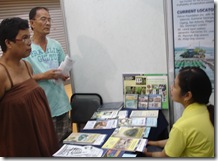 DOST Visayas S&T fair. AQD participated in the Department of Science and Technology (DOST) Region 6 Visayas Science and Technology Fair with the theme Responding to global challenges through science and technology last August 17-22 at SM City Bacolod.
DOST Visayas S&T fair. AQD participated in the Department of Science and Technology (DOST) Region 6 Visayas Science and Technology Fair with the theme Responding to global challenges through science and technology last August 17-22 at SM City Bacolod.
The event aimed to promote public awareness on the critical role of science and technology (S&T) in national development.
New flyers from AQD
Twelve new flyers, hot off the press, showcase AQD’s various products and services, as well as technology profiles of some aquaculture commodities. These flyers are freely downloadable from the AQD website at www.seafdec.org.ph/publications_downloadable.html.
- AQD officials & commodity contact persons, a bookmark-type publication
- AQD laboratory services, on various diagnostic services and rates
- Hatchery seedstock, information on AQD’s hatchery seedstock, details on prices and payment of various seedstock for sale
- Aquaculture training, contains schedules, fees, contact information on AQD’s training programs, including internships and on-the-job training
- Backyard hatchery, a 4-page flyer on the abalone and marine fish small-scale hatchery situated at AQD’s Tigbauan Main Station
- Seed production of bighead carp, includes basic information on the breeding and larval rearing of the bighead carp Aristichthyis nobilis
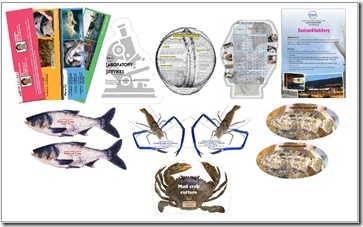 Grow-out production of bighead carp, on the grow-out culture of A. nobilis
Grow-out production of bighead carp, on the grow-out culture of A. nobilis - Seed production of giant freshwater prawn, on the broodstock, larval rearing and nursery of the giant freshwater prawn Macrobrachium rosenbergii
- Grow-out production of giant freshwater prawn, information on the grow-out culture of M. rosenbergii in ponds and cages
- Hatchery & nursery of grouper, contains technology profiles and techniques in the hatchery and nursery of the grouper Epinephelus spp.
- Grow-out culture of grouper, information on site selection and culture techniques in the grow-out of Epinephelus spp.
- Mud crab culture, includes site selection, culture conditions and methods, and financial indicators on the pond culture of the mud crab Scylla serrata
Typhoon Ondoy affects AQD’s Binangonan station
 Typhoon Ondoy (international name: Ketsana), which hit the Philippines last September 24-26, left behind massive damage to lives and properties in its wake. AQD’s Binangonan Freshwater Station (BFS) was not spared of its fury.
Typhoon Ondoy (international name: Ketsana), which hit the Philippines last September 24-26, left behind massive damage to lives and properties in its wake. AQD’s Binangonan Freshwater Station (BFS) was not spared of its fury.
Some BFS pens and cages in Laguna Lake were submerged. BFS staff managed to retrieve stocks from the submerged cages and transfer them to tanks. The BFS disaster brigade, headed by Technician Federico Reyes, together with guards of the Carmela Security Agency, helped save 75% of the lake-based stocks. Some that were affected included the catfish stocks of Associate Researcher Ms. Antonietta Evangelista, prawn and tilapia stocks of Scientist Dr. Ma. Lourdes Aralar, and non-experimental carp stocks.
Aside from these, Typhoon Ondoy did not cause as much damage to BFS as Typhoon Milenyo did in 2006.
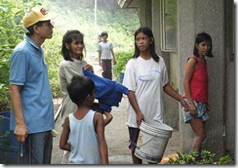 Evacuees find refuge at BFS. The intense rain brought about by Typhoon Ondoy caused massive flooding in the area, displacing many families. Because of this, the Sangguniang Barangay of Pipindan, through Barangay Captain Hoseas Montevilla, requested BFS Head Engr. Emiliano Aralar to let the families use the BFS Dormitory Building as an evacuation center. There are 20 families staying in the dormitory, with a total of 90 persons, including children.
Evacuees find refuge at BFS. The intense rain brought about by Typhoon Ondoy caused massive flooding in the area, displacing many families. Because of this, the Sangguniang Barangay of Pipindan, through Barangay Captain Hoseas Montevilla, requested BFS Head Engr. Emiliano Aralar to let the families use the BFS Dormitory Building as an evacuation center. There are 20 families staying in the dormitory, with a total of 90 persons, including children.
BFS staff brought relief goods (food and clothes) for distribution to the evacuees.
Dr. Clarissa Marte retires from AQD
 Dr. Clarissa Marte officially retired from AQD last September 15 after almost three decades of service.
Dr. Clarissa Marte officially retired from AQD last September 15 after almost three decades of service.
She started working at AQD in 1977 as a Research Associate and eventually rose up the ranks. Among the positions she held during her long and distinguished career included the following: Head of Igang Substation; Supervisor of the Microtechnique Service Laboratory; Project Leader of the Finfish Broodstock Project, Technical Team Member of the National Bangus Breeding Program; and Head of the Breeding Section of the Research Division. She eventually headed two divisions of AQD: the Research Division (1987-1991; 1995-2003) and the Technology Verification and Demonstration Division (2007-2009).
Dr. Marte’s research work has focused on the reproductive endocrinology of marine fishes, particularly that of milkfish. Moreover, she was actively involved in AQD’s implementation of the Coastal Fishery Resources Management (CFRM)Project in Malalison Island in Culasi, Antique. In the process, she has authored and co-authored more that 40 papers published in local and international journals.
AQD Chief Dr. Joebert Toledo paid tribute to Dr. Marte, saying that she was his first boss. He considered Dr. Marte not only as a supervisor, but also a mother. He also remarked that given her experience as a researcher, AQD needs her wisdom and advice. Dr. Toledo expressed hope that she always have a place in her heart for AQD.
In his message, Deputy Chief Dr. Teruo Azuma said that the AQD community has a lot of respect for Dr. Marte. He also said that while he will miss her, he hoped that she could find time to visit AQD.
Training & Information Head Mr. Renato Agbayani reminisced that it was 50 years ago that he first met Dr. Marte when they were still high school students at the University of the Philippines Preparatory School. He also spoke of the time they worked together in Malalison, calling it an experience worth learning. “Mabuhay ka!” said Mr. Agbayani.
Other AQD staff also spoke about their experiences working with Dr. Marte, and they considered her not only as a boss but also as a friend, sister, tennis competitor, and an inspiration to the younger people at AQD.
Dr. Marte thanked everyone for their heartwarming messages and was glad that all of her efforts were appreciated. She also noted that many of those who worked under her have progressed into really good scientists and researchers. She also said that although she has retired, she will still be around for AQD.
As she begins another chapter in her journey, AQD wishes Dr. CLM good luck, godspeed, and all the best in her future endeavors.
WiFi @ AQD
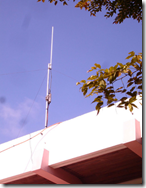 To expand AQD’s internet access, a Wireless Fidelity (WiFi) antenna was installed at the rooftop of the Tigbauan Main Station dormitory last July 7.
To expand AQD’s internet access, a Wireless Fidelity (WiFi) antenna was installed at the rooftop of the Tigbauan Main Station dormitory last July 7.
It has an ideal coverage of 500 m radius.
The purpose of the WiFi installation are to (1) give AQD trainees 24/7 internet access during their stay at AQD and (2) generate income through the offering of prepaid access cards to the AQD community. Subscribers will have internet access from 6 pm to 7 am during weekdays (so as not to hamper with the internet access of AQD offices) and full access during weekends. Fee of the prepaid access will be half of the current internet carriers’ rate.
AQD’s computer network office earlier tested the setup through free internet access tickets valid for July.
The WiFi is a D-link DWL-7700AP that supports a/b/g WiFi technology with a 12-dbi external antenna.
